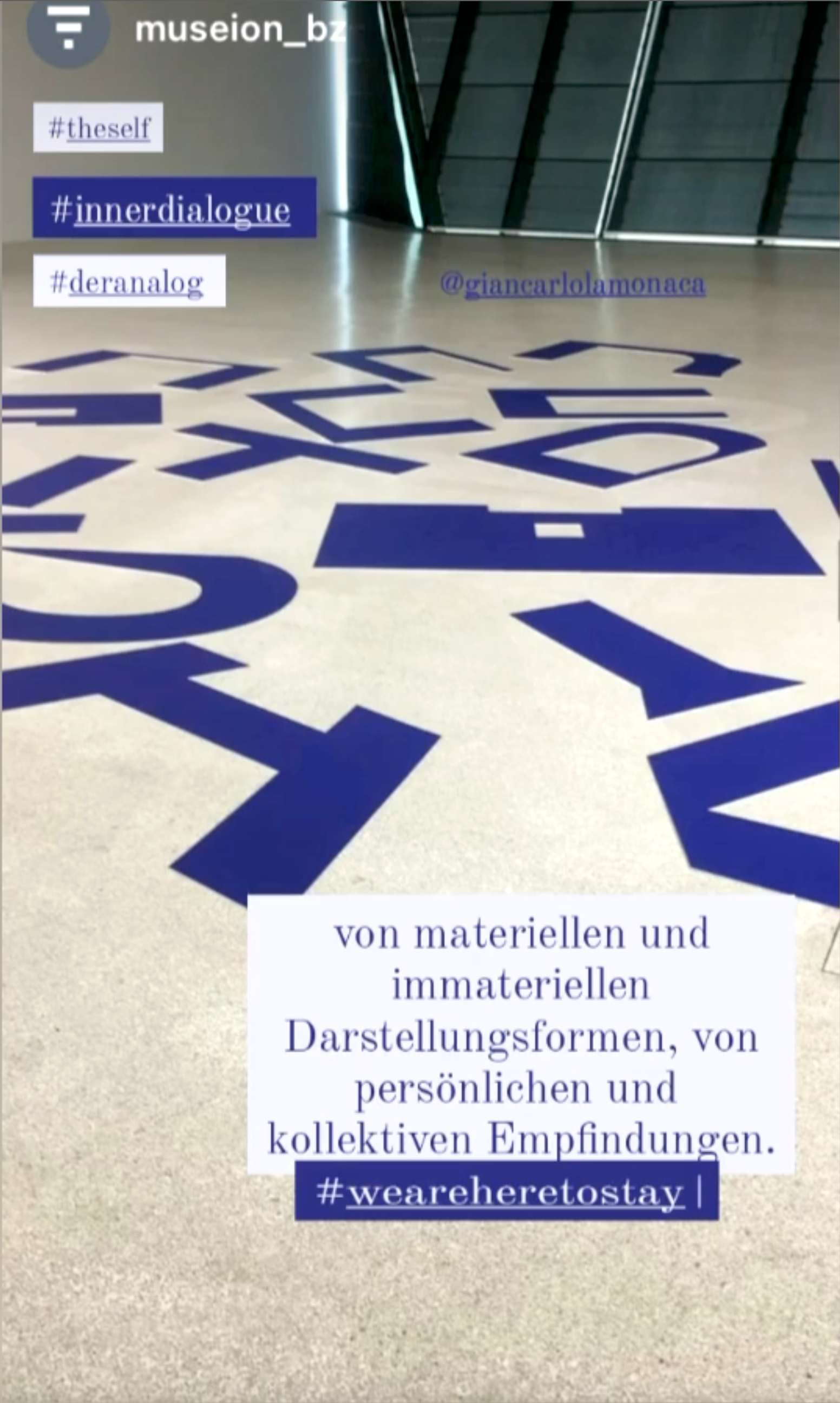





DE
Stolpersein
Die performative Installation Stolpersein ist eine Schichtung von inneren und Äußeren Erfahrungen, von materiellen und immateriellen Darstellungsformen, von persönlichen und kollektiven Empfindungen. Stolpersein stellt den Anfang der Rückkehr zum Selbst dar.
Der Analog II ist Teil einer Serie von Arbeiten inspiriert vom Roman „Der Berg Analog“ (von René Daumal). Ein nicht-euklidischer, alpinistischer Abenteuerroman der den Berg als Bindeglied zwischen Himmel und Erde, Menschen und Göttern, Symbol des Aufstiegs und Allegorie des höchsten Seins darstellt. Der Analog II ist von der Natur inspiriert, eine teils dicht verwobene, undurchdringliche und unwirtliche Natur die dem menschlichen Dasein gegenübersteht und sich schließlich als Komplementär erweist. Die Arbeit mutiert zum Gebetsteppich, zur Meditationsmatte die sich mit dem meditierenden Subjekt visuell vereint und identifiziert.
Der Noise- Sound interpretiert das Gayatri Mantra, das als die Essenz der Veden (der vedischen Schriften, Anm. d. Verf.) gilt. Gayatri ist die Mutter allen Wissens. Sie ist gegenwärtig, wo immer ihr Name erwähnt wird. Bhur, Bhuvah und Swah im Mantra beziehen sich auf den Körper, die Lebenskraft und die Seele. Alle drei sind im Menschen vorhanden. Zuerst wird das Göttliche gepriesen, dann meditiert und schließlich erfolgt ein Appell, um das Unterscheidungsvermögen des Menschen zu erwecken. „... ihr seid nicht eins, sondern drei: der, für den ihr euch haltet, der, für den andere euch halten und der, der ihr wirklich seid.“ (Zitat aus: Sri Sathya Sai spricht, Band 33.04)
Der performte Text „Sein- wer glaubt“ stellt einerseits den inneren Dialog, eine aus der Meditation entspringenden, wenn auch distanzierten Stimme dar. Andererseits eine Entfremdung aus der Kollektivität, eine „außen“ stehende Stimme, auch wertend, in Frage stellend, scheinbar übergeordnet. Eine den Dualismus frönende, diesem unterlegene aber offenbar unausweichliche Stimme. Es sind Abschweifungen im Bereich des Ephemeren, der Veränderung, der Existenzfrage nach dem sein. „Es ist in dieser nicht möglichen Begrenzung der physischen Welt“, schreibt Ghirri, „dass Kunst Bedeutung findet“.
Der Analog II ist Teil einer Serie von Arbeiten inspiriert vom Roman „Der Berg Analog“ (von René Daumal). Ein nicht-euklidischer, alpinistischer Abenteuerroman der den Berg als Bindeglied zwischen Himmel und Erde, Menschen und Göttern, Symbol des Aufstiegs und Allegorie des höchsten Seins darstellt. Der Analog II ist von der Natur inspiriert, eine teils dicht verwobene, undurchdringliche und unwirtliche Natur die dem menschlichen Dasein gegenübersteht und sich schließlich als Komplementär erweist. Die Arbeit mutiert zum Gebetsteppich, zur Meditationsmatte die sich mit dem meditierenden Subjekt visuell vereint und identifiziert.
Der Noise- Sound interpretiert das Gayatri Mantra, das als die Essenz der Veden (der vedischen Schriften, Anm. d. Verf.) gilt. Gayatri ist die Mutter allen Wissens. Sie ist gegenwärtig, wo immer ihr Name erwähnt wird. Bhur, Bhuvah und Swah im Mantra beziehen sich auf den Körper, die Lebenskraft und die Seele. Alle drei sind im Menschen vorhanden. Zuerst wird das Göttliche gepriesen, dann meditiert und schließlich erfolgt ein Appell, um das Unterscheidungsvermögen des Menschen zu erwecken. „... ihr seid nicht eins, sondern drei: der, für den ihr euch haltet, der, für den andere euch halten und der, der ihr wirklich seid.“ (Zitat aus: Sri Sathya Sai spricht, Band 33.04)
Der performte Text „Sein- wer glaubt“ stellt einerseits den inneren Dialog, eine aus der Meditation entspringenden, wenn auch distanzierten Stimme dar. Andererseits eine Entfremdung aus der Kollektivität, eine „außen“ stehende Stimme, auch wertend, in Frage stellend, scheinbar übergeordnet. Eine den Dualismus frönende, diesem unterlegene aber offenbar unausweichliche Stimme. Es sind Abschweifungen im Bereich des Ephemeren, der Veränderung, der Existenzfrage nach dem sein. „Es ist in dieser nicht möglichen Begrenzung der physischen Welt“, schreibt Ghirri, „dass Kunst Bedeutung findet“.
Stolpersein, eine Performative Installation von Giancarlo Lamonaca, Text interpretiert und performt von Lene Morgenstern, Sound von BuTe (www.bute-projects.it) in Zusammenarbeit mit Francesco Tancredi, Szenenköstüm geschneidert von Clara Castlunger
Museion, Bolzano / Bozen, May 5. 2021
_________________
EN
Stolpersein
The performative installation Stolpersein is a layering of inner and outer experiences, of material and immaterial forms of representation, of personal and collective sensations. Stolpersein represents the beginning of the return to the self.
Der Analog II is part of a series of works inspired by the novel "Der Berg Analog" (by René Daumal). A non-Euclidean, alpinist adventure novel that depicts the mountain as a link between heaven and earth, humans and gods, a symbol of ascent and an allegory of the highest being. Der Analog II is inspired by nature, a partly dense, impenetrable and inhospitable nature that confronts the human existence and finally proves to be complementary. The work mutates into a prayer rug, a meditation mat that visually unites and identifies with the meditating subject.
The noise sound interprets the Gayatri mantra, which is considered the essence of the Vedas (the Vedic scriptures, author's note). Gayatri is the mother of all knowledge. She is present wherever her name is mentioned. Bhur, Bhuvah and Swah in the mantra refer to the body, the life force and the soul. All three are present in the human being. First, the Divine is praised, then meditation takes place, and finally an appeal is made to awaken man's discernment. "... you are not one, but three: the one you think you are, the one others think you are, and the one you really are." (Quote from: Sri Sathya Sai Speaks, Volume 33.04)
The performed text "Sein- wer glaubt" represents on the one hand the inner dialogue, a voice arising from meditation, albeit distanced. On the other hand, an alienation from collectivity, an "outside" voice, also evaluating, questioning, seemingly superior. A voice indulging in dualism, inferior to it but apparently inescapable. These are digressions in the realm of the ephemeral, of change, of the existential question of being. "It is in this impossible limitation of the physical world," Ghirri writes, "that art finds meaning."
Stolpersein, a performative installation by Giancarlo Lamonaca, text interpreted and performed by Lene Morgenstern, sound by BuTe (www.bute-projects.it) in collaboration with Francesco Tancredi, scenic costume tailored by Clara Castlunger
Museion, Bolzano / Bozen, May 5. 2021